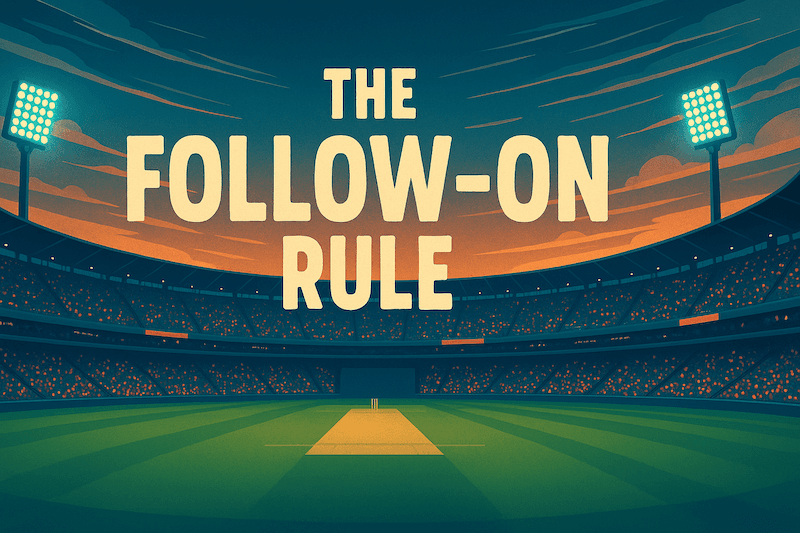
There is a special kind of tension in Test cricket when a team builds a big first innings lead. The bowlers have done their job, the batters have piled on the runs, and now all eyes turn to the captain. Should he make the opposition bat again or give his players a rest? That one call, to enforce the follow on or not, can decide how the match unfolds.
The follow on is more than a rule, it is a test of nerve and belief. It shows control and confidence, but also carries great risk. When a captain says, “We will make them bat again,” he is making a statement that his team is in charge. Yet in Test cricket, even the strongest position can turn in a single session.
Understanding the Follow-On Rule
The follow-on is a rule in Test and first-class cricket that allows the team batting first to make the opposition bat again immediately if they have built a big enough lead. In a five-day Test, that lead must be at least 200 runs.
To put it simply, if Team A scores 500 and Team B is bowled out for 299 or less, Team A has the right to enforce the follow-on. But it’s not automatic, it’s a strategic call left entirely to the captain. Sometimes, a captain may choose to bat again instead, either to give the bowlers a break or to build an even bigger target.
How the Follow-On Started
The idea of the follow-on has been around for centuries. It first appeared as a cricket custom in 1787 and later became a mandatory law in 1835, requiring teams with big leads to make the opposition bat again. The aim was simple: to avoid dull draws and keep matches competitive at a time when stronger sides often skipped their second innings.
By the early 1900s, the rule became optional, turning it from an obligation into a tactical choice that added more strategy and psychology to the game.
Why the Lead Matters
The 200 run lead in a five day Test isn’t random, it shows the level of control a team needs before making the opponent bat again. The margin changes for shorter matches, usually 150 runs for three or four days, 100 runs for two days, and 75 runs for one day first-class games.
The reasoning is simple: the longer the match, the more time a trailing side has to recover, so a bigger lead is needed to justify enforcing the follow-on. For captains, though, the decision depends on far more than numbers — pitch conditions, weather, and bowler fatigue all play a major role.
Explore More Stories

2005 Ashes: The Summer Cricket Became Theatre
The 2005 Ashes was more than just a cricket series. It was a rollercoaster of emotion, courage, and unforgettable moments that brought Test cricket back to life. England’s long wait finally ended, and the world watched history unfold.

Wasim Akram: The Sultan of Swing Who Made Fast Bowling an Art
From the streets of Lahore to World Cup glory, Wasim Akram’s journey is the story of a left-arm genius who turned fast bowling into pure art.
Legendary Follow-On Moments
In the long history of Test cricket, there have been only four instances where a team has managed to win after being forced to follow on, and in a twist of fate, Australia has been on the losing side in most of them.
- The first miracle unfolded in 1894 between England and Australia, when England turned the tables and won a close contest by 10 runs.
- The second came in 1981, once again between England and Australia, when Ian Botham’s all-round brilliance inspired England to a stunning 18-run victory at Headingley.
- The most unforgettable moment was the 2001 Kolkata Test. When India followed on against Australia, few gave them a chance, until Dravid and Laxman produced one of the greatest comebacks in cricket history to give India a famous 171-run win.
- The latest chapter came in 2023, when New Zealand faced England. Kane Williamson’s composed century anchored a stunning fightback that led to a dramatic one-run victory, adding another unforgettable twist to the story of the follow on.
Why Captains Hesitate to Enforce the Follow-On
The follow on, once a sign of dominance, is now a careful tactical call. Captains know that one wrong move can turn control into pressure.
Bowler fatigue plays a big part. After building a strong lead, bowlers are often tired, and asking them to bowl again straight away can reduce their impact. Many captains instead bat again, extend the lead, and give their bowlers time to recover.
With the T20 mindset influencing modern cricket, batters now score quickly and fight back harder, even when following on. The psychological battle is just as tricky, enforcing it shows power, but it can also fuel the opposition’s resolve. That is why today, the follow on remains a brave but risky gamble.
The Future of the Follow-On
There is ongoing debate about whether the follow on rule still suits modern cricket. With flatter pitches, high scores, and tighter schedules, some believe the 200 run margin should be reduced to 150 to encourage more attacking captaincy, while others think the rule is fine and that captains simply need more courage to use it. A few even suggest making the follow on automatic or linking it to overs bowled instead of runs.
Yet, the rule’s psychological impact remains its greatest strength. The threat of being asked to bat again keeps teams alert and adds drama to every Test. Even if rarely used, the follow on continues to stand as a symbol of control and courage — a reminder that one brave decision can still change the course of a match. In the end, the follow on captures the very essence of Test cricket: a contest of skill, patience, and daring.





